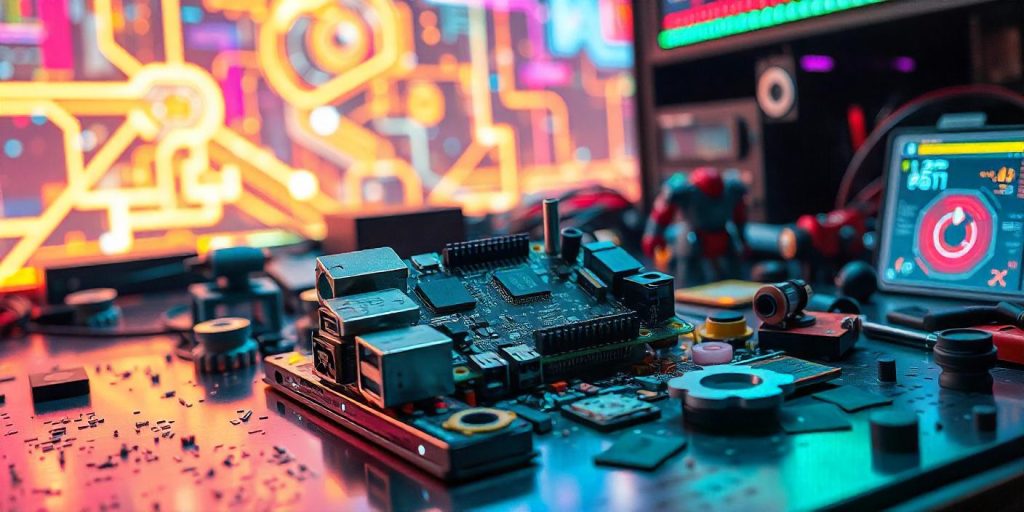Many applications, including those for fundamental programming education and robotics, rely on single-board computers (SBCs), and a number of SBCs figure prominently in the current market. Among the most prominent are the Raspberry Pi and the Orange Pi, both of which see considerable use. When it comes to the workings of these two boards, people lump them together because they serve similar functions. However, lumping the two together ignores their distinct designs and features. Why are we discussing them collectively? Well, we’re going to do just that for the following few passages, and we’ll try to pick apart the Orange Pi and Raspberry Pi in a way that gives you a clearer sense of both.
What is Raspberry Pi?
You can refer to the Raspberry Pi as a mini-computer. It is a small device, the size of a credit card, which can be plugged into a PC that has standard peripherals (a keyboard and mouse). Especially with the Python language (which it supports “out of the box”), it is a fully functional computer that can teach everyday programming tasks. Generally, meteorological-related programs employ the Raspberry Pi series of devices to create aerial drones. Most people recognize these devices for their affordable price and their exceptional capabilities. And the price is quite variable—ranging from $5 to more than $100 per device.
Advantages of Raspberry Pi
- Affordable: The Raspberry Pi is available in several kinds at varying prices, which enables it to have a place in all of society.
- Extensive community support: Because it is so popular, there is a vast amount of information available about its use, especially when it comes to troubleshooting and providing guidance during the training phase.
Its multiple usability features include its suitability for instructional settings, its ability to generate DIY commodities, its use in media centers, its gaming capabilities, and its capacity to serve the essential functions of a desktop for mundane everyday tasks.
- Broad software compatibility: There is compatibility with operating systems, including the Raspberry Pi OS, Ubuntu, and other Linux systems.
Disadvantages of Raspberry Pi
- Performance limitations: Although it is powerful within its operating parameters, this unassuming board only provides basic functionality and may struggle with heavier applications compared to some other single-board PCs.
- RAM options may be limited: The specific computer models selected might have space constraints for RAM.
What is Orange Pi?
Another mini-computer available on the market is the Orange Pi. The high demand for the Raspberry Pi led to the development of the Orange Pi, a competitor. Although it costs less to produce than the original, the Orange Pi delivers a computing experience that is nearly indistinguishable from the Raspberry Pi. However, unlike the original, the Orange Pi lacks significant community support. Moreover, unlike the Raspberry Pi and Orange Pi, the Odroid, if it qualifies as one, is the next competitor to their unwavering reputation as fanless mini-computers.
Advantages of Orange Pi
- High performance: On the whole, models of Orange Pi tend to have faster processors and more RAM, which makes them better suited to handle the kinds of complex, computationally intensive tasks that demand more from a workhorse machine.
- A varied model selection: A more extensive selection of models means that the board can select one that better serves its needs.
- Affordable: Typically offered at a relatively low price, it still delivers significant performance advantages.
Disadvantages of Orange Pi
- Limited communal assistance: One drawback of the Orange Pi is that it lacks the community development that the Raspberry Pi enjoys. Therefore, if someone is using an Orange Pi and needs assistance, they are much less likely to find a relevant community to help them than someone using a Raspberry Pi.
- Problems of compatibility with software: As discussed in the preceding section, it is compatible with many operating systems. However, certain distributions exhibit compatibility and stability problems.
Difference between Raspberry Pi and Orange Pi
Raspberry Pi and Orange Pi are both well-known single-board computers (SBCs) used in a range of applications, from basic educational projects to sophisticated computing jobs. While they share some common features, they differ significantly in terms of hardware specifications, software support, community, and application types. Here is a detailed head-to-head comparison of the two.
1. Hardware Specifications
- The Raspberry Pi typically uses processors from the ARM Cortex-A series. To illustrate, the Raspberry Pi 4 Model B has a quad-core Cortex-A72 (ARM v8) processor.
- Orange Pi Provides a much broader array of processors, including those from Allwinner and Rockchip. For example, the Orange Pi 4 uses a Rockchip RK3399, which is more potent than what the Raspberry Pi 4 has to offer.
RAM:
- Raspberry Pi comes in 1GB, 2GB, and 8GB RAM configurations.
- Orange Pi Offers multiple models with RAM options from 512MB to 4GB or more, depending on the model.
Memory:
- The Raspberry Pi relies on microSD cards for storage but can also utilize USB drives.
- Orange Pi: Offers microSD memory as well as eMMC memory on most models, which allows for much quicker data access.
Connectivity:
- Raspberry Pi: In the latest iterations, typical models come with HDMI, USB ports, Ethernet, and Wi-Fi.
- Orange Pi: Generally outfitted with HDMI, USB ports, and Ethernet, it often comes with extra GPIO pins, but not all models are guaranteed to have Wi-Fi.
2. Software Support
Raspberry Pi:
It provides strong support for Raspbian (now Raspberry Pi OS), an operating system based on Debian. An active community provides extensive support, offering numerous tutorials, forums, and project ideas. – It is compatible with various programming languages and platforms, such as Python, Scratch, and others.
Orange Pi:
- It provides assistance for various operating systems such as Armbian, Ubuntu, and Android.
- The community is growing but not as large as that of Raspberry Pi.
- Some software compatibility issues may arise due to the variety of hardware.
3. Community and ecosystem
Raspberry Pi:
- This is a long-established community that boasts a vast array of resources, projects, and educational materials.
- We establish strong partnerships with educational institutions and organizations to promote learning and innovation.
Orange Pi:
- A smaller but increasingly vibrant community.
- You can find relevant resources and project examples, but they don’t match the Raspberry Pi’s level of comprehensiveness.
4. Use cases.
Raspberry Pi:
This is ideal for beginners, educational purposes, and projects carried out by enthusiasts.
It is frequently employed in undertakings related to the “do-it-yourself” ethos, as well as in the contexts of media and the Internet of Things.
Orange Pi:
The Orange Pi is suitable for advanced users who require exceptional performance and flexibility.
Applications such as artificial intelligence, robotics, and multimedia tasks require a higher level of processing power.
Conclusion
Both Raspberry Pi and Orange Pi have their unique advantages and disadvantages. Raspberry Pi is frequently the default option for novices and teaching because of the vast array of materials and community support surrounding it. On the other hand, Orange Pi serves those looking for beefier hardware that allows for more flexibility and power in the kinds of projects one might undertake. The choice between the two depends on the project and knowledge level.

